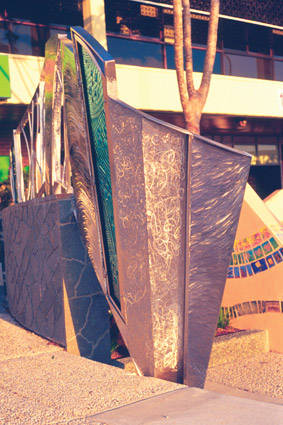
To symbolise the wetlands landscape of the Nundah area in Brisbane’s north, sculptor Daniel Della Bosca sought out materials which best convey the fluidity and reflectivity of water and the reedy texture of waterside vegetation.
 His choice was 316 stainless steel, finished with specialised surface treatments, combined with translucent blue glass and earthed in basalt.
His choice was 316 stainless steel, finished with specialised surface treatments, combined with translucent blue glass and earthed in basalt.
“Dancing Wall” was commissioned by Brisbane City Council (BCC) as part of its program of Suburban Centre Improvement Projects (SCIPs) which aim to improve economic vitality, focus on community life and enrich local activity. The Nundah SCIP is one of the larger projects in the scheme with a budget of $2.5m.
The artwork is a sculptural balustrade set on the hilltop at the corner of Buckland Street and Sandgate Road. Its design symbolises the local environment which was once rich in waterholes and is now the focus of BCC and Wildlife Preservation Society rehabilitation initiatives.
According to Della Bosca, the piece is not just about the past: the materials and design provide an inspirational link to the future.
The client has expressed satisfaction with the completed project, with Deputy Mayor Councillor Quinn commenting that it fulfills the Council’s objectives of “good design and creative activity to build a prosperous city.”
FABRICATION
“Dancing Wall” was fabricated by Della Bosca in grade 316 stainless plate, flat bar and rod supplied by ASSDA member Austral Wright Metals. It houses five panels of slumped and toughened ‘azurelite’ glass, made by artist Shar Moorman, internally illuminated by concealed LED lighting.
Most of the structure was fabricated from rolled stock to bring an organic quality to the design. The intricate forming was carried out by local firm BJR Metal Rolling & Pressing who specialise in rolling compound curves.
SURFACE FINISH
Integral to the design are the surface treatments which suggest reed and water textures. ASSDA member Australian Industrial Abrasives helped to investigate the products, appropriate tooling and techniques to achieve the desired effects. The finishing on larger areas was completed with a Dynacushion on a variable speed sander polisher, using abrasive belts in a range from P80 to P150 Zirconia/Alox and finishing with 3M Blue Scotchbrite. The tighter, more intricate areas were finished using a Dynafile and various contact arms and the same range of abrasive belts.
An easily achievable, cost-effective maintenance schedule using an activated surfactant cleaner quarterly and a passivation gel as required has been implemented by Brisbane City Council.
The cleaning agent removes oil, grease and dirt, and also removes surface free iron which may cause discolouration or more serious corrosion.
This step is followed by a passivation gel which chemically generates the chrome oxide passive film on the surface to enhance corrosion resistance for stainless steel installed in high corrosion environments.
ARTISTIC POSSIBILITIES
Della Bosca says the qualities of stainless steel can best be conveyed by allowing the material to interact with light. “As fabricators well know it is easy to ‘muddy’ the surface of stainless, but if care is taken and correct procedures followed, the metal can give opportunities to a surface finisher.
“I work with the stainless to allow it to speak of more than itself. This is much more important to me than trying to force a finish.”
This article featured in Australian Stainless Issue 24 - March 2003.